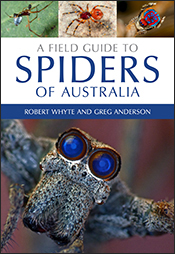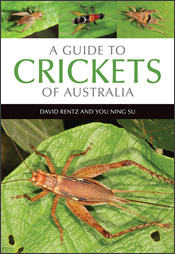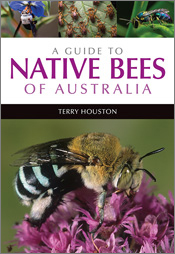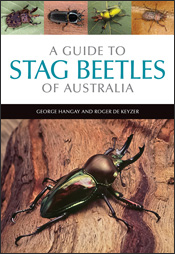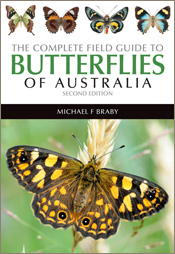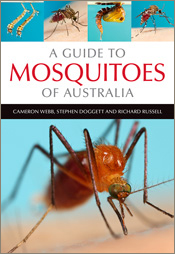A Field Guide to Spiders of Australia

By: Robert Whyte, Greg Anderson
The most comprehensive account of Australian spiders ever published.
Australians have a love–hate relationship with spiders. Some spiders, such as the Redback and the Sydney Funnelweb, inspire fear. Yet Peacock Spiders, with their colourful fan-spreading courtship dances, have won rapturous appreciation worldwide. + Full description
A Field Guide to Spiders of Australia uses photographs of living animals to help people identify many of the spiders they encounter. Featuring over 1300 colour photographs, it is the most comprehensive account of Australian spiders ever published. With more than two-thirds of Australian spiders yet to be scientifically described, this book sets the scene for future explorations of our extraordinary Australian fauna.
This field guide will be enjoyed by naturalists and anyone with an interest in learning more about Australia's incredible arachnids.
Recipient of the 2018 Whitley Certificate of Commendation for Field Guide
- Short descriptionNews
Read more on our blog:
From alien butts to ant mimics, we leafed through the pages of A Field Guide to Spiders of Australia to find some great reasons to admire our eight-legged friends: Appreciating Amazing Aussie Arachnids
View the media release (PDF) for A Field Guide to Spiders of Australia.
Reviews
“Read no further – unless you are willing to fall in love with spiders. Submitting to the pages that follow could change your life..." – Tim Low, excerpt from the Preface
"It is a beautiful and very useful book, and remarkable for the abundance of photographs... Never mind being a Field Guide, I will be quite happy in my armchair looking at this for some time to come. Oh, and fans of charismatic jumping spiders rejoice — you have 85 pages to drool over! This book gets a big tick from me!"
Helen Smith, Society for Insect Studies Circular, #187, June 2017
"Robert Whyte and Greg Anderson are well aware that a lot of people don't share their passion; hence, the tone of the book is welcoming and conversational... Once seduced by the charm of spiders, you'll find yourself entranced by their ways and amused by the authors' entertaining style."
Owen Seeman, Wildlife Australia, Spring 2017
"It may just change your mind about arachnids, and help you identify many of the spiders you have encountered. Not all are scary!"
Ally Jackson, Gardening Australia, August 2017
"This field guide will allow 'arachnophobes' to see beauty in spiders for the first time... Snippets of biological interest are scattered throughout the book, and it is only by reading all of it that one will learn of the many mind-boggling truths that remain hidden outside of the human sphere... A magnificent work from cover to cover, this guide to the spiders of Australia offers a refreshing read, one well pitched to an educated lay audience and the scientist alike."
Kelvyn L. Dunn, Metamorphosis Australia - magazine of the Butterfly and Other Invertebrates Club, #86, September 2017
"What surprised me was the conversational style of the species accounts – in a way it read like a novel, and for the first time in my life I read a field guide as one. I read it from start to finish in two lengthy sittings."
Joan Faiola, The Spider Club News 33(3), October 2017
"worthy of a place on the bookshelves of any arachnological or natural history library... It will no doubt serve as the springboard for future Australian professional arachnologists, whilst also promoting a greater understanding and appreciation of these often maligned animals within the general population... I highly recommend this book!"
David Penney, Newsletter of the British Arachnological Society 139, 2017
"The spider imagery presented throughout this book is superb for its quality, variety and attention to detail. The over 1300 spider images, contributed by 62 photographers, are the stars of this book. Images of juveniles, intraspecific variations, undescribed and named species are all displayed... I thoroughly recommend this book for personal enjoyment, as a field guide or as a way to enthuse someone new to the field of Australian spiders."
Ken Walker, The Victorian Naturalist 134(4), 2017
"The book is packed with fascinating information that will equip you to identify that visitor scuttling across your lounge-room wall. You'll also discover how beautiful spiders can be, the huge variety of spiders, and how many more new species there are still to discover... This book is going to become a staple in my library."
Rowena Morcom, Good Reading, July 2017
"readers will find this book both fascinating and useful. It might even spark some interest in your non-spider-loving family members!"
Tanya Marwood, WA Naturalists' Club Newsletter, 31 May 2017
"This truly fabulous book... will help us to get to know these arachnids much better... With probably two thirds of our spiders still not identified we should all be heading out, this book in hand and eyes wide open, to look more closely at these incredible creatures."
Penny Woodward, Organic Gardener, 2017
"This book is primarily an identification guide, although with only 4,000 of the estimated 15,000 to 20,000 species formally described it is inevitable that you will soon come across an undescribed species... I will be making extensive use of it as I attempt to identify my own spider photos. And even if my spiders fall through the gaps, I should at least be closer to knowing who the miniature hunters are that I come across of a daily basis."
Euan Moore, Park Watch (271), December 2017
"I am personally indebted to the authors that have achieved in one wonderful book, what I have aimed to convey to others all my arachnological life: that spiders are amazing and deserve much more appreciation and admiration than we begrudgingly bequeath them...
I highly recommend this book, which you can trust to be the current authoritative reference on Australian spiders for your children, your community group or your own backpack!"
Dr Tracey Churchill, Proceedings of the Royal Society of Queensland 123(10), 2018
"Whyte and Anderson's book is different. ...their passions for spiders and their photographic skills are evident from the very first page."
Graham Brown, General and Applied Entomology 45 2017
"Many schools take their students on nature walks or camps armed with basic field guides allowing the students to identify the plants or animals that they find. Until now there wasn’t one that the teachers could use to help identify
the spiders that may be encountered. This book fills that void and I would highly recommend that schools have at least one copy available in their science resources."
Peter Hope, Let's Find Out journal 34(3), 2017
Details
Paperback | June 2017 | $ 49.95ISBN: 9780643107076 | 464 pages | 215 x 148 mm
Publisher: CSIRO Publishing
Colour photographs
ePDF | June 2017
ISBN: 9780643107083
Publisher: CSIRO Publishing
Available from eRetailers
ePUB | June 2017
ISBN: 9780643107090
Publisher: CSIRO Publishing
Available from eRetailers
Features
- Covering all known Australian spider families and heavily illustrated with over 1300 colour photographs
- Highly accurate and vetted by experts, it contains the most up-to-date taxonomy information
- Stunning macro-photography reveals the fascinating details not discernible to the naked eye
- Written in an accessible and engaging style
- Fills a major gap in Australian natural history
Contents
ForewordPreface
Acknowledgements
Introduction
From arachnophobia to arachnophilia
How to use this book
Determining species – everything helps, including genitals
Australia’s rich arachnological history
Parts of a spider: the need-to-know terms
Shortcuts to identification
Spider families from A to Z
Araneomorphae
Mygalomorphae
Little-known Spider Families
Glossary
Photo credits
Readings
Index
Spiders: family tree
Index of family common names
View the full table of contents.
Authors
Robert Whyte is an honorary researcher in arachnology at the Queensland Museum, having developed an interest in spiders with the encouragement of arachnologist Robert Raven. He has participated in five Bush Blitz biodiscovery expeditions in remote parts of Western Australia, the Northern Territory and Queensland. He is an accomplished editor, author and journalist, with skills in photography and publication design.
Greg Anderson is a biomedical research scientist and heads the Chronic Disorders Program at the QIMR Berghofer Medical Research Institute in Brisbane. He has been interested in spiders since his early life in Newcastle and has travelled extensively around Australia and other parts of the world studying and photographing spiders. He has a particular interest in Comb-footed Spiders.

